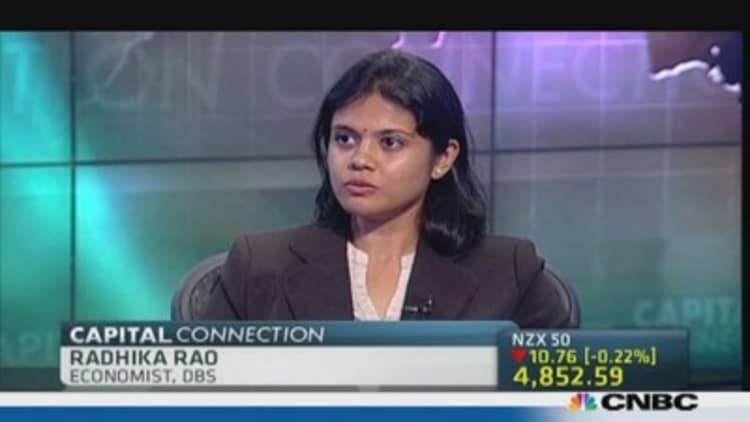Indian equities have had a stellar run over the past two months, recently rising to a three-year high, but analysts warn that the market rally is ripe with risks.
"Investors ought to be cautious on India. The economy will continue to suffer from a poor growth-inflation mix, leading to a high cost of capital," said Nicholas Ferres, investment director at Eastspring Investments.
"In this context, the valuation multiple for the market does not provide sufficient compensation for risk, in my view," he added. The benchmark S&P BSE Sensex is trading at a price-to-earnings ratio of 16.8.
(Read more: India's central bank targets inflation, but high prices may persist)

Indian shares have surged around 13 percent since the U.S. Federal Reserve's decision to delay tapering its $85-billion-a-month asset-purchase program in late August, driven by robust inflows from foreign investors.
Geoff Lewis, global market strategist at J.P. Morgan Asset Management, who has an underweight position on India, is also cautious on the outlook for the market given sluggishness in the broader economy.
(Read more: Is India'seconomy finally getting its groove back?)
"We look for more analyst earnings downgrades in coming months in response to the slowing economy," he said. India's economy is expected to grow 4.7 percent in the fiscal ending next March after expanding 5 percent in the previous year, which was the weakest since 2002-2003.
"We are also concerned that if there is another wave of outflows from emerging market triggered by Fed tapering, then India could see more significant outflows than in the summer," he added. Foreign investors withdrew around $3.8 billion from the local stock markets between June-August as concerns around tapering reached fever pitch.
(Watch now: India needs at least 8% annual growth: Expert)
The central bank is expected to maintain its bond-purchasing program until April 2014, according to the latest CNBC survey of economists, strategists and money managers.

Politics will also be a source of uncertainty for the market before the upcoming general elections scheduled to take place by May 2014, said strategists.
"Currently, the election looks very hard to call, and adds to market uncertainty," Lewis said.
"But investors would probably welcome signs that the Bharatiya Janata Party [the main opposition party] was moving into the lead, as Narendra Modi could be expected to kickstart the reform process. That is a scenario we would need to be aware of, given our current underweight position," he added.
Narendra Modi, who is serving as the chief minister of India's Gujarat state, is the BJP's candidate for prime minister. He has been applauded by the business community for his investor-friendly policies that have led Gujarat to double-digit economic growth.
Nomura, which upgraded Indian stocks to an overweight on Tuesday, cited the upcoming five-state elections - which will be held between November 11 and December 4 - as a positive driver for the market.
"We expect the BJP to perform strongly in the state elections. If the BJP emerges stronger from the state elections, this would be seen as increasing the likelihood of a BJP-led government at the center. Sentiment could improve as a result, since the BJP is seen as more market friendly and more amenable to structural reforms," wrote Sonal Varma, India economist and Alastair Newton, senior political strategist at Nomura in a report.
Markets are still reaping the "honeymoon" benefits from Raghuram Rajan's accession to the RBI governorship on September 4, the bank added.
(Read now: The 'sexy' central banker who's causing a stir)
Deustche Bank also has an optimistic view on the market. Last week, the bank raised its year-end target for the Sensex to a record-high 22,000 from 21,000 – around 5 percent above current levels.
The bank cited factors including receding investor pessimism, a bottoming out in the economy and withdrawal of liquidity tightening measures by India's central bank.
—By CNBC's Ansuya Harjani; Follow her on Twitter:@Ansuya_H


